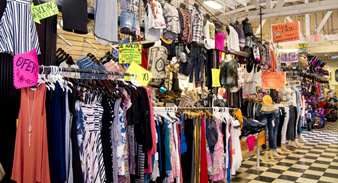Given that 1979, El Faro Plaza has actually ended up being Los Angeles's premiere indoor market, including over 250 suppliers, crafters, artists from all over the world, a true mix of Angelenos. This indoor swap meet, situated in Los Angeles, is a one-stop shopping center offering a wide array of stores, food suppliers, and home entertainment for the whole household. And all at a fantastic price! From foot massages to automobile window tinting, from lingerie to quinceanera gowns, from exotic birds to tvs, we have everything under one giant roof.An indoor swap meet in the United States, especially Southern California and Nevada, is a kind of exchange, a permanent, indoor shopping mall open during regular retail hours, with fixed cubicles or shops for the vendors.Indoor swap meets house suppliers that sell a variety of products and services, specifically clothes and electronics. For instance, vendors in the Fantastic Indoor Flea Market in Las Vegas sell
clothes, furniture, handbags and toys, ... however there's a ton more: flowers and plants, family pet supplies, leather items, sporting equipment, fragrance and cosmetics, baggage and electronic devices, to call just a couple of. There also are cubicles for services, including window tinting, palm reading, changes, engraving and estate preparation. The majority of products sold here are brand-new, although antique alley does include some vintage and second-hand items. It is different in format to an outside swap meet, the equivalent of a flea market, typically open on a minimal number of days and typically without fixed areas for its vendors.

Indoor swap meets exist in numerous working-class neighborhoods across Southern California, with a concentration in Central Los Angeles. Indoor swap meets consist of the Anaheim Marketplace, Fantastic Indoor Flea Market in Las Vegas, and the High Desert Indoor Swap Meet in Victorville. [5] Longstanding indoor swap meets that are now defunct consist of the Pico Rivera Indoor Swap Meet [6] and San Ysidro Indoor Swap Meet.Swap fulfills in the U.S. long consisted of U.S.-born suppliers who sold primarily secondhand items in outdoor areas. In the 1970s, Latino immigrants started offering cultural goods and cost effective services at swap meets in Southern California and some swap meets started looking like the tianguis, open-air markets, of Mexico. At the same time, drive-in movie theaters were ending up being less popular, and their owners eagerly leased them out throughout the day to outdoor swap meets, which multiplied. Then, mostly Korean immigrants utilized their connections in the growing import/export trade with Asia to set up their own swap meet stalls and equip them with new, inexpensive items from Asia instead of pre-owned items. In the 1980s and 1990s as residential or commercial properties South Los Angeles and Additional reading parts of Central L.A. ended up being abandoned and hence, cheap, Korean immigrants purchased them and turned them into indoor swap meets.